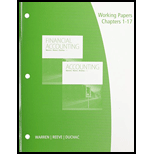
Working Papers, Chapters 1-17 for Warren/Reeve/Duchac's Accounting, 26th and Financial Accounting, 14th
26th Edition
ISBN: 9781305392373
Author: Carl Warren, Jim Reeve, Jonathan Duchac
Publisher: Cengage Learning
expand_more
expand_more
format_list_bulleted
Concept explainers
Question
Chapter 3, Problem 3.18EX
To determine
Adjusting entries refers to the entries that are made at the end of an accounting period in accordance with revenue recognition principle, and expenses recognition principle. All adjusting entries affect at least one income statement account (revenue or expense), and one
Rules of Debit and Credit:
Following rules are followed for debiting and crediting different accounts while they occur in business transactions:
- Debit, all increase in assets, expenses and dividends, all decrease in liabilities, revenues and
stockholders’ equities . - Credit, all increase in liabilities, revenues, and stockholders’ equities, all decrease in assets, expenses.
To prepare: The adjusting entry at the end of the year.
Expert Solution & Answer
Trending nowThis is a popular solution!

Students have asked these similar questions
What is the receivables turnover ratio for this financial accounting question?
Question: Dina Co. manufactures fine dining tables. During the most productive month of the year, 3,500 tables were manufactured at a total cost of $84,400. In its slowest month, the company made 1,100 tables at a cost of $46,000. Using the high-low method of cost estimation, what is the total fixed costs in August for Dina?
what is the cost per unit?
Chapter 3 Solutions
Working Papers, Chapters 1-17 for Warren/Reeve/Duchac's Accounting, 26th and Financial Accounting, 14th
Ch. 3 - How are revenues and expenses reported on the...Ch. 3 - Is the matching concept related to (a) the cash...Ch. 3 - Why are adjusting entries needed at the end of an...Ch. 3 - What is the difference between adjusting entries...Ch. 3 - Identify the four different categories of...Ch. 3 - If the effect of the debit portion of an adjusting...Ch. 3 - If the effect of the credit portion of an...Ch. 3 - Does every adjusting entry affect net income for...Ch. 3 - Prob. 9DQCh. 3 - (a) Explain the purpose of the two accounts:...
Ch. 3 - Accounts requiring adjustment Indicate with a Yes...Ch. 3 - Accounts requiring adjustment Indicate with a Yes...Ch. 3 - Type of adjustment Classify the following items as...Ch. 3 - Prob. 3.2BPECh. 3 - Prob. 3.3APECh. 3 - Adjustment for prepaid expense The prepaid...Ch. 3 - Prob. 3.4APECh. 3 - Prob. 3.4BPECh. 3 - Adjustment for accrued revenues At the end of the...Ch. 3 - Adjustment for unearned revenue The balance in the...Ch. 3 - Adjustment for prepaid expense The prepaid...Ch. 3 - Adjustment for prepaid expense The supplies...Ch. 3 - Adjustment for depreciation The estimated amount...Ch. 3 - Adjustment for depreciation The estimated amount...Ch. 3 - Prob. 3.8APECh. 3 - Prob. 3.8BPECh. 3 - Effect of errors on adjusted trial balance For...Ch. 3 - Effect of errors on adjusted trial balance For...Ch. 3 - Prob. 3.10APECh. 3 - Prob. 3.10BPECh. 3 - Prob. 3.1EXCh. 3 - Prob. 3.2EXCh. 3 - Prob. 3.3EXCh. 3 - Prob. 3.4EXCh. 3 - Prob. 3.5EXCh. 3 - Prob. 3.6EXCh. 3 - Adjusting entries for prepaid insurance The...Ch. 3 - Prob. 3.8EXCh. 3 - Prob. 3.9EXCh. 3 - Prob. 3.10EXCh. 3 - Adjusting entries for unearned and accrued fees...Ch. 3 - Prob. 3.12EXCh. 3 - Prob. 3.13EXCh. 3 - Prob. 3.14EXCh. 3 - Prob. 3.15EXCh. 3 - Prob. 3.16EXCh. 3 - Prob. 3.17EXCh. 3 - Prob. 3.18EXCh. 3 - Determining fixed assets book value The balance in...Ch. 3 - Prob. 3.20EXCh. 3 - Prob. 3.21EXCh. 3 - Prob. 3.22EXCh. 3 - Effects of errors on financial statements The...Ch. 3 - Effects of errors on financial statements If the...Ch. 3 - Adjusting entries for depreciation; effect of...Ch. 3 - Prob. 3.26EXCh. 3 - Adjusting entries from trial balances The...Ch. 3 - Prob. 3.28EXCh. 3 - Prob. 3.29EXCh. 3 - Prob. 3.1APRCh. 3 - Prob. 3.2APRCh. 3 - Prob. 3.3APRCh. 3 - Adjusting entries Good Note Company specializes in...Ch. 3 - Prob. 3.5APRCh. 3 - Adjusting entries and errors At the end of April,...Ch. 3 - Prob. 3.1BPRCh. 3 - Prob. 3.2BPRCh. 3 - Prob. 3.3BPRCh. 3 - Prob. 3.4BPRCh. 3 - Prob. 3.5BPRCh. 3 - Prob. 3.6BPRCh. 3 - The unadjusted trial balance that you prepared for...Ch. 3 - Ethics and professional conduct in business Daryl...Ch. 3 - Accrued revenue The following is an excerpt from a...Ch. 3 - Prob. 3.3CP
Knowledge Booster
Learn more about
Need a deep-dive on the concept behind this application? Look no further. Learn more about this topic, accounting and related others by exploring similar questions and additional content below.Similar questions
arrow_back_ios
SEE MORE QUESTIONS
arrow_forward_ios
Recommended textbooks for you
 Intermediate Accounting: Reporting And AnalysisAccountingISBN:9781337788281Author:James M. Wahlen, Jefferson P. Jones, Donald PagachPublisher:Cengage LearningPrinciples of Accounting Volume 1AccountingISBN:9781947172685Author:OpenStaxPublisher:OpenStax College
Intermediate Accounting: Reporting And AnalysisAccountingISBN:9781337788281Author:James M. Wahlen, Jefferson P. Jones, Donald PagachPublisher:Cengage LearningPrinciples of Accounting Volume 1AccountingISBN:9781947172685Author:OpenStaxPublisher:OpenStax College Individual Income TaxesAccountingISBN:9780357109731Author:HoffmanPublisher:CENGAGE LEARNING - CONSIGNMENT
Individual Income TaxesAccountingISBN:9780357109731Author:HoffmanPublisher:CENGAGE LEARNING - CONSIGNMENT

Intermediate Accounting: Reporting And Analysis
Accounting
ISBN:9781337788281
Author:James M. Wahlen, Jefferson P. Jones, Donald Pagach
Publisher:Cengage Learning

Principles of Accounting Volume 1
Accounting
ISBN:9781947172685
Author:OpenStax
Publisher:OpenStax College

Individual Income Taxes
Accounting
ISBN:9780357109731
Author:Hoffman
Publisher:CENGAGE LEARNING - CONSIGNMENT


Accounting for Derivatives_1.mp4; Author: DVRamanaXIMB;https://www.youtube.com/watch?v=kZky1jIiCN0;License: Standard Youtube License
Depreciation|(Concept and Methods); Author: easyCBSE commerce lectures;https://www.youtube.com/watch?v=w4lScJke6CA;License: Standard YouTube License, CC-BY